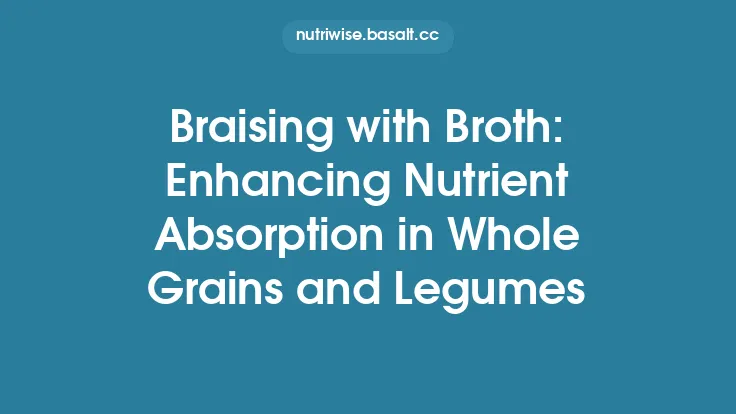Smart carbohydrate sources are the cornerstone of a diet that fuels the body efficiently while supporting long‑term health. Unlike refined sugars and heavily processed grains, the foods highlighted here deliver complex carbohydrates, ample dietary fiber, and a suite of micronutrients that together promote stable blood glucose, satiety, and gut health. Below, we explore the most nutrient‑dense carbohydrate options—whole grains, legumes, and a range of “beyond‑grain” choices—detailing their biochemical makeup, health impacts, and practical ways to incorporate them into everyday meals.
Whole Grains: Nutrient Profile and Benefits
What qualifies as a whole grain?
A true whole grain contains three intact components of the seed: the bran (outer layer), the germ (embryonic core), and the endosperm (starchy interior). Retaining all three parts preserves the grain’s natural balance of macronutrients and phytonutrients.
| Component | Key Nutrients | Functional Role |
|---|---|---|
| Bran | Dietary fiber (especially insoluble), B‑vitamins (thiamine, niacin, B6), minerals (iron, magnesium, zinc) | Adds bulk to stool, slows gastric emptying, supports microbiome |
| Germ | Healthy fats (including omega‑3 α‑linolenic acid), vitamin E, antioxidants (phytosterols) | Provides antioxidant protection, contributes to cell membrane integrity |
| Endosperm | Starch (amylose & amylopectin), small amounts of protein | Primary energy source; amylose content influences glycemic response |
Amylose vs. Amylopectin
Starch is a polymer of glucose units arranged in two distinct structures:
- Amylose – Linear chains that are less readily digested, leading to a slower rise in blood glucose and higher resistant starch formation during cooling (e.g., in cooked‑then‑cooled rice or pasta).
- Amylopectin – Highly branched, rapidly hydrolyzed, producing a quicker glucose surge.
Grains with a higher amylose-to‑amylopectin ratio (e.g., barley, certain varieties of brown rice, and sorghum) are generally considered “smarter” carbohydrate sources because they moderate post‑prandial glucose spikes.
Health Highlights
- Improved Glycemic Control – The combination of fiber, resistant starch, and a favorable amylose profile blunts post‑meal glucose excursions, which is especially beneficial for individuals with insulin resistance.
- Cardiovascular Protection – Soluble fiber (β‑glucan) in oats and barley lowers LDL‑cholesterol by binding bile acids in the intestine.
- Gut Microbiome Support – Fermentable fibers act as prebiotics, fostering short‑chain fatty acid (SCFA) production (butyrate, propionate) that sustains colonic health and modulates inflammation.
Top Whole Grain Picks
| Grain | Amylose % | Notable Fiber | Key Micronutrients |
|---|---|---|---|
| Barley (hulled) | 30–35% | β‑glucan (4–5 g/100 g) | Selenium, magnesium |
| Oats (whole‑grain rolled) | 25–30% | β‑glucan (3–4 g/100 g) | Manganese, phosphorus |
| Quinoa (pseudocereal) | 20–25% | Soluble + insoluble (≈2.8 g/100 g) | Iron, magnesium, complete protein |
| Farro (spelt) | 30% | Insoluble (≈3 g/100 g) | Zinc, B‑vitamins |
| Brown rice | 22–28% | Insoluble (≈1.8 g/100 g) | Manganese, selenium |
Legumes: Carbohydrate Quality and Complementary Nutrients
Legumes—beans, lentils, peas, and chickpeas—are often celebrated for their protein content, but they also deliver high‑quality carbohydrates that are uniquely beneficial.
Carbohydrate Structure
Legume starch is typically high in amylose (≈30–35 %) and contains a substantial proportion of resistant starch (RS 2) that resists digestion in the small intestine. Additionally, legumes are rich in non‑starch polysaccharides such as pectins, galactomannans, and raffinose family oligosaccharides (RFOs). While RFOs can cause flatulence in some individuals, they also serve as prebiotic substrates for beneficial gut bacteria.
Fiber Profile
- Soluble fiber (e.g., pectin) – Lowers cholesterol and improves glycemic response.
- Insoluble fiber – Increases fecal bulk and promotes regularity.
A typical ½‑cup (≈100 g) serving of cooked lentils provides ~8 g of total fiber, with roughly 2 g being soluble.
Micronutrient Synergy
Legumes are dense sources of:
- Folate – Essential for DNA synthesis and methylation.
- Iron (non‑heme) – Enhanced absorption when paired with vitamin C‑rich foods.
- Magnesium & potassium – Support vascular tone and electrolyte balance.
Health Implications
- Blood Sugar Modulation – The high amylose and fiber content yields a low to moderate glycemic index (GI ≈ 30–45 for most beans).
- Satiety & Weight Management – The combination of protein and fiber prolongs gastric emptying, reducing overall caloric intake.
- Cardiometabolic Benefits – Regular legume consumption is linked to lower LDL‑cholesterol and reduced risk of type 2 diabetes.
Practical Legume Choices
| Legume | GI (approx.) | Resistant Starch (g/100 g cooked) | Notable Micronutrients |
|---|---|---|---|
| Black beans | 30 | 1.5 | Folate, iron |
| Green lentils | 35 | 1.2 | Magnesium, B‑vitamins |
| Chickpeas | 33 | 1.0 | Copper, manganese |
| Split peas | 32 | 1.4 | Vitamin K, phosphorus |
| Edamame (young soybeans) | 38 | 0.8 | Calcium, vitamin C (when fresh) |
Pseudocereals and Ancient Grains: Expanding the Carbohydrate Palette
Pseudocereals (e.g., quinoa, amaranth, buckwheat) and ancient grains (e.g., teff, millet, sorghum) are not true cereals botanically, yet they function similarly in culinary contexts. Their carbohydrate profiles often surpass conventional wheat in terms of quality.
Key Features
- Higher Protein Completeness – Many contain all essential amino acids, reducing the need for complementary protein sources.
- Rich in Micronutrients – Notably iron, calcium, and magnesium, which are sometimes limited in refined grains.
- Favorable Starch Composition – Several ancient grains have a higher amylose content, contributing to lower GI values.
Nutrient Highlights
| Pseudocereal/Ancient Grain | Amylose % | Total Fiber (g/100 g) | Prominent Micronutrients |
|---|---|---|---|
| Quinoa | 20–25% | 7 (mixed) | Iron, magnesium, lysine |
| Amaranth | 22% | 6.7 | Calcium, phosphorus |
| Buckwheat | 30% | 10 | Manganese, copper |
| Teff | 28% | 8 | Calcium, iron |
| Millet | 30% | 8.5 | Magnesium, phosphorus |
| Sorghum | 30–35% | 6.5 | Phenolic antioxidants |
Culinary Applications
- Breakfast porridges – Cooked millet or teff with nuts and fruit.
- Salad bases – Quinoa or amaranth tossed with vegetables and vinaigrette.
- Baking – Buckwheat flour for pancakes or sorghum flour for flatbreads, often blended with whole‑grain wheat for texture.
Starchy Vegetables and Tubers: Carbohydrate Sources with a Twist
While grains dominate discussions of smart carbs, certain vegetables and tubers provide high‑quality carbohydrates alongside a robust phytonutrient matrix.
Sweet Potatoes – High in amylose (≈30%) and rich in β‑carotene. The fiber is predominantly soluble, contributing to a moderate GI (≈44).
Winter Squash (e.g., butternut, acorn) – Contain a blend of starch and soluble fiber, plus vitamins A and C.
Cassava (Yuca) – A staple in many tropical regions; when processed minimally (e.g., boiled or baked) it offers a high‑amylose starch (≈30–35%) but is low in micronutrients, so pairing with nutrient‑dense foods is advisable.
Key Takeaway – Starchy vegetables deliver carbohydrates with a lower energy density than refined grains, and their accompanying vitamins, minerals, and antioxidants enhance overall diet quality.
Carbohydrate Quality Metrics: Beyond the Glycemic Index
To evaluate carbohydrate sources objectively, consider a combination of the following metrics:
- Glycemic Index (GI) & Glycemic Load (GL) – GI measures the relative rise in blood glucose; GL adjusts GI for typical serving size.
- Amylose/Amylopectin Ratio – Higher amylose correlates with slower digestion and greater resistant starch formation.
- Total Dietary Fiber (soluble vs. insoluble) – Soluble fiber improves lipid profiles; insoluble fiber supports bowel regularity.
- Resistant Starch (RS) Content – RS acts like fiber, fermenting in the colon to produce SCFAs.
- Micronutrient Density – Vitamins, minerals, and phytochemicals per gram of carbohydrate.
A “smart” carbohydrate source typically scores low‑to‑moderate GI, high amylose, abundant fiber (especially soluble), notable RS, and a rich micronutrient profile.
Combining Carbohydrate Sources for Balanced Meals
Synergistic Pairings
- Whole Grain + Legume – Combining, for example, brown rice with black beans creates a complete amino acid profile while blending low‑GI starches with additional fiber.
- Grain + Starchy Vegetable – A quinoa‑sweet‑potato bowl offers varied starch types (amylose‑rich quinoa, amylose‑rich sweet potato) and a spectrum of phytonutrients.
- Pseudocereal + Nuts/Seeds – Adding chia or hemp seeds to buckwheat porridge boosts omega‑3 fatty acids and protein, enhancing satiety.
Meal Timing Considerations
- Pre‑Workout – Opt for higher‑glycemic carbs (e.g., a small portion of cooked white rice or a banana) 30–60 minutes before intense activity for rapid energy.
- Post‑Workout – Pair moderate‑GI carbs (e.g., lentil soup) with protein to replenish glycogen and support muscle repair.
- Evening – Favor low‑GI, high‑fiber options (e.g., barley or teff porridge) to promote stable overnight glucose and sustained satiety.
Practical Tips for Selecting and Preparing Smart Carbohydrates
- Choose Whole Over Refined – Look for “whole grain,” “whole‑seed,” or “unprocessed” on packaging.
- Mind the Cooking Method – Over‑cooking can gelatinize starch, raising GI. Aim for al dente textures when possible.
- Leverage the “Cool‑Then‑Reheat” Trick – Cooking and then cooling grains or potatoes increases resistant starch; reheating does not fully reverse this effect.
- Batch‑Cook and Portion – Prepare large quantities of quinoa, lentils, or barley and store in portion‑sized containers for quick meal assembly.
- Season with Herbs & Spices – Adding turmeric, cinnamon, or rosemary not only enhances flavor but also contributes antioxidant compounds.
- Combine with Acidic Foods – A squeeze of lemon or a side of tomato salsa can improve iron absorption from legumes and grains.
Sustainability and Environmental Perspective
Many smart carbohydrate sources align with sustainable agriculture:
- Legumes fix atmospheric nitrogen, reducing the need for synthetic fertilizers.
- Ancient Grains often require less water and are more drought‑tolerant than modern wheat.
- Pseudocereals can be cultivated on marginal soils, expanding food security in regions with limited arable land.
Incorporating these foods not only benefits personal health but also supports ecological resilience.
Closing Thoughts
Smart carbohydrate choices—whole grains, legumes, pseudocereals, and nutrient‑rich starchy vegetables—provide a harmonious blend of complex starches, dietary fiber, and essential micronutrients. By understanding the underlying starch chemistry (amylose vs. amylopectin), fiber types, and resistant starch formation, you can select foods that stabilize blood glucose, nourish the gut microbiome, and contribute to long‑term cardiovascular and metabolic health. Pairing these carbs thoughtfully within meals maximizes nutrient synergy, supports sustainable eating patterns, and ensures that the energy you consume fuels both body and mind in the most efficient, health‑promoting way possible.





